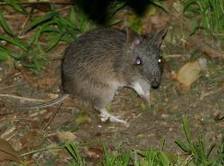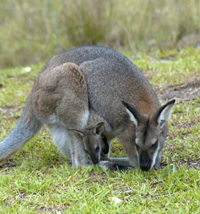The Threat to Wildlife
Whereas the question of cruelty is focused largely on rabbits the question of carelessness centres on the risk of collateral damage — the killing of non-target species. Non-target species include humans and pets, as well as wildlife.
Every program of pest eradication by poison has to take into account the effect it will have on both target and non-target species. To do this it has to take account of the effects, and the risks, of both primary and secondary poisoning of animals. Primary poisoning occurs when target and non-target animals consume baits; secondary poisoning occurs when predators eat sick animals that have been poisoned or scavengers eat the carcasses of poisoned animals.
There are few studies of the toxicity of pindone to Australian native fauna. According to a 2002 survey of the literature by the National  Registration Authority for Agricultural and Veterinary Chemicals (NRA – now the APVMA) the available information "indicates that a number of native species (macropods [kangaroos and wallabies], bandicoots, dasyurids, raptors and a range of granivorous birds) are likely to share the high
Registration Authority for Agricultural and Veterinary Chemicals (NRA – now the APVMA) the available information "indicates that a number of native species (macropods [kangaroos and wallabies], bandicoots, dasyurids, raptors and a range of granivorous birds) are likely to share the high  sensitivity of rabbits to pindone (NRA 2002: 7, 33)”.
sensitivity of rabbits to pindone (NRA 2002: 7, 33)”.
The reason given for the NRA review was that: “Poisoning during baiting operations of non-target animals using either form of pindone in baits were identified in WA and NSW in particular. States and some community groups have expressed concerns about poisonings of non-target animals, including both intentional and unintentional misuse.” (NRA 2002: 9)
